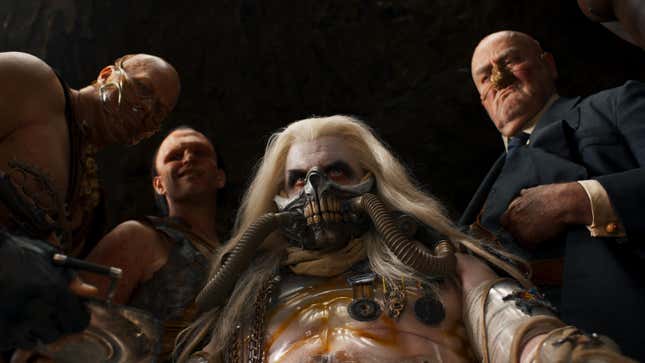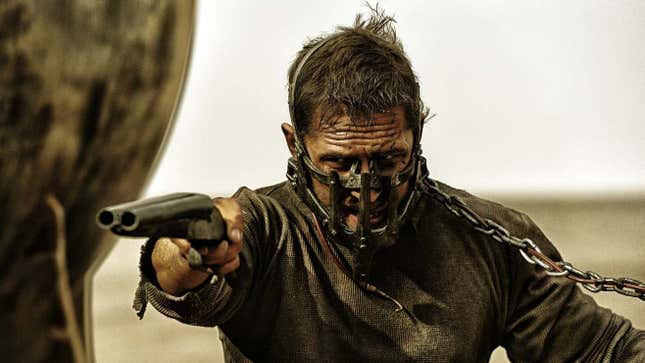
During the press tour for Mad Max: Fury Road, filmmaker George Miller was asked repeatedly how the film connected to the previous three installments in the Mad Max franchise. It was a fair question, prompted mainly by the fact that Tom Hardy, an actor in his 30s, was recast in the title role originated by Mel Gibson, who’s about 20 years his senior. Was it supposed to be a sequel? A reboot? A reimagining? Miller danced around the question time and time again, most often coming back to the term “revisiting.” What that means exactly only Miller knows, but it doesn’t do much to clear up the continuity of the franchise in any way that makes sense. Now that the prequel, Furiosa: A Mad Max Saga, is in theaters, those timeline inconsistencies are in our face all over again. Which forces us, as fans, to ask ourselves: Does it really matter?
There’s a reason Miller doesn’t like answering questions about trivial canon details in the world of Mad Max; it’s because he doesn’t ask them of himself. He tells the stories he wants to tell in the way he wants to tell them without worrying about how they all fit together. That seems a bit incongruous coming from a filmmaker known for his extensive worldbuilding, but keeping track of alternate history is not part of his process. “It’s basically an episode in the life of Max and this world,” Miller said of Fury Road at a press conference in Cannes, where the film premiered in 2015. “I never wrote the story, any of the stories, with a chronological connection.”
Tales from the wasteland
Indeed, it’s difficult to draw a historical line from one Mad Max film to the next. The original 1979 film wasn’t even supposed to be set in the future at all. Miller envisioned it as a contemporary action thriller, but he couldn’t afford to build sets or hire extras on his limited budget, so he made the decision late in the production to set it in a desolate near future. Or, as the opening tells us, “a few years from now.” That would place it sometime in the early 1980s. Not yet a wasteland, but not the world as we think of it either. A roaming band of bikers terrorize the sparsely populated towns, already scavenging for petrol. At this point, Max Rockatansky is still an officer of the Main Force Patrol, or MFP, until he becomes disillusioned and walks away to be with his wife and son. That doesn’t work out so great for him, or them. The tone of this scrappy little indie, which didn’t get much attention outside of Australia, is miles away from the films that would follow it.
In Mad Max 2—or The Road Warrior, as it was titled in the U.S.—the landscape is much harsher, and representative of the post-apocalyptic aesthetic we now associate with the franchise. In the film’s opening voiceover narration we get a vague update on the state of the world. “Two mighty warrior tribes went to war and touched off a blaze which engulfed them all.” Fuel has become a rare commodity, sought after by the savage gangs who terrorize the roads on modified bikes, trucks, and muscle cars. We are introduced to a tougher version of Max too, who’s been wandering the wasteland, haunted by his past. There’s no precise date given to tie the film to any time period, but we know that it takes place about three years after the first one. That would put it in the range of the mid-’80s.
It’s not until the third film, Mad Max: Beyond Thunderdome, that we finally get confirmation of a nuclear holocaust, though it’s still unclear when exactly the bomb (or bombs) fell. Society has completely broken down at this point, though places like Bartertown have cropped up, with a functioning power grid and some semblance of order. Every design element from the second film is pushed further here—the mohawks are taller, the shoulder pads wider, and the gear is chunkier. Even Max has grown out his hair into a flowing mane. Based on information gathered through supplemental material like books and comics, the gap between the second and third film is around 15 years (it was just four years in real time), which brings us up to the start of the 21st century.
Although each of the films in the original trilogy has its own distinct personality, they still feel like individual parts of a single, evolving story. It would be 30 years before Miller finally managed to return to the world of Mad Max (after years of failed attempts), and a lot changed in those intervening decades. So much so that the critically acclaimed fourth film would stand on its own as a singular achievement.
When the canon wheels start coming off
Fury Road is where things gets stuck in a bit of a quagmire, continuity-wise. It’s a career high for Miller, but it bears such a loose connection to the films that came before it that it ultimately amounts to a Mad Max film in name only. Fury Road would still have worked if he’d called Hardy’s character anything else. Or if Miller had cast an actor around the same age as Gibson to take over the role of Max. Or if he’d changed the script to explain Hardy’s youth. But Miller didn’t do any of those things. He wanted to make the fourth Mad Max film he never got to make in the ‘80s, with a much bigger budget, so that’s what he did.
If timeline consistency isn’t something that concerns the architect of these stories much, why should we care? Some don’t. There are plenty of people out there who are content to enjoy each Mad Max film on its own terms. It’s a sensible approach if all you’re after is a wild ride of escalating spectacle. It certainly makes for a more pleasant viewing experience when you don’t let yourself get distracted by the contradictions. But not everyone can let them go so easily. And that’s okay, too. Just as it’s Miller’s prerogative to ignore everything that came before when crafting a new story, it’s also fine to point out the holes. Some people enjoy puzzling things out and trying to make the pieces fit.

These types of viewers may find it distracting, for instance, when Tom Hardy’s Max says he “used to be a cop.” That personal fact significantly shortens the distance between Mad Max and Fury Road. Hardy doesn’t look older than 40 at the most, which gives the world only about two decades to go from the crumbling yet still recognizable society of Mad Max to the desolate, post-apocalyptic wasteland plagued by savage marauders and homicidal warlords we see in Fury Road. And everyone around the same age as Max would have to also remember the time before. Maybe they would have had a life, a job, a house. Normal clothes! Think about what was going on in your life in 2004, and how recent that seems. If you look closely you can see repurposed technology like cell phones and modified car models that weren’t on the market in the 1980s. This seems to be an alternate timeline in which the world fell much later.
And then there’s the first trailer for Furiosa, which further complicates the issue by placing her kidnapping at precisely “45 years after the collapse.” In Fury Road she tells the Vuvalini that it’s been 7,000 nights (roughly 19 years), give or take, since her abduction. Putting these figures together, it would mean Fury Road takes place 64 years after the fall of civilization. Unless Max was a cop during the apocalypse, which would change his entire origin story, that puts his age at somewhere around 90. That 45-year figure didn’t appear in any of the other trailers, so you might just chalk this one up to a marketing snafu, but you can also start to see the appeal of the “don’t worry about it” approach.
“This ain’t one body’s story, it’s the story of us all.”
As it happens, there’s a way to bring together all of these different iterations of the Mad Max saga in a way that makes narrative sense within the universe. One explanation that’s been offered by fans is that each of the films represents a future “telling” of a myth of the past featuring Max as a legendary hero of the wasteland. The discrepancies can be explained by the evolution of the tales as a kind of oral history, campfire stories passed down from one generation to another, like “the tell” of the Lost Tribe kids in Thunderdome. This is supported by the framing of Mad Max 2 as a narrative told by The Feral Kid as a full-grown adult, and further substantiated by the knowledge passed down by The History Man in Furiosa. At the end of the film, he offers us alternate conclusions, suggesting that this story has been passed around many times. Maybe all of them have. If you think of the Mad Max franchise in terms of mythology rather than chronology (as Miller himself seems to), it all makes a lot more sense.